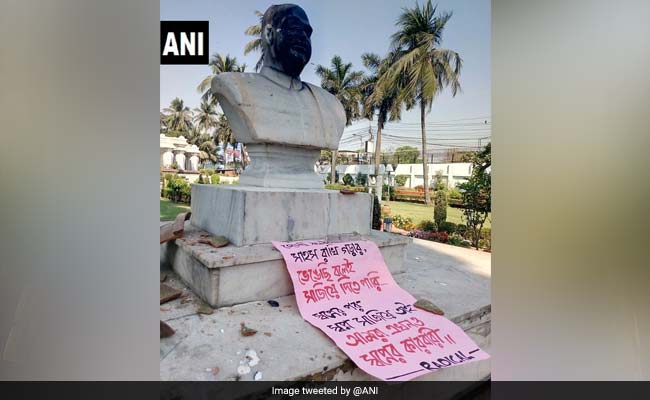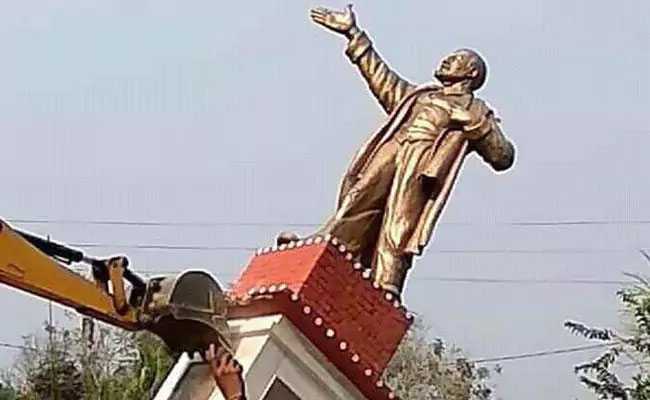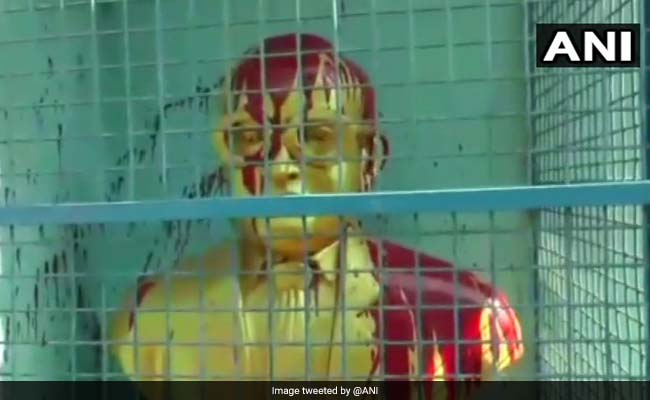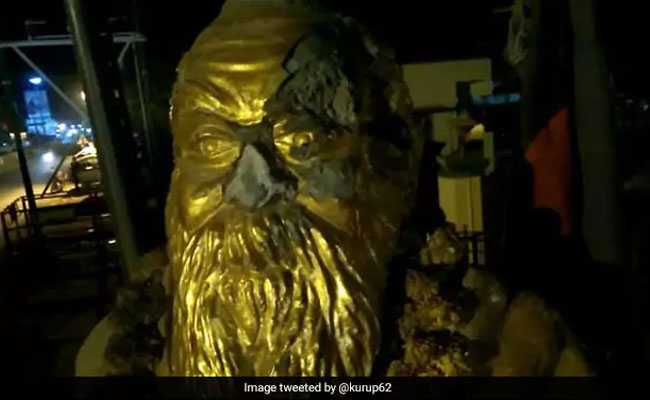In a case of selective amnesia, critics of this act of vandalism in Tripura have barely mentioned similar actions of the ultra-Left in the past in West Bengal in particular where statues of Mahatma Gandhi and Swami Vivekananda used to be routinely disfigured in the 1960s and '70s. Some over-enthusiastic BJP leaders have not covered themselves with glory either; Tamil Nadu leader H Raja saying that Dravidian ideologue Ramaswamy Periyar's statue should be the next target invited a rebuke from none other than Prime Minister Narendra Modi. The frenzy gathered momentum lately when CPI(M) supporters apparently vandalized a statue of the erstwhile Jana Sangh's founder president Syama Prasad Mookerjee.

A bust of BJP icon Syama Prasad Mookerjee was blackened and damaged in Kolkata
Although mob fury against erstwhile rulers at the conclusion of a long stint of their rule is a natural way of expressing political jubilation, it is an undesirable way of attempting the erasure of history. Following the collapse of the Soviet state, statues of Lenin and Stalin were destroyed all across the erstwhile Soviet Union. Stalin in particular continues to be reviled the world over for the massacre of over a million people during his tyrannical rule. It is only in the CPM's offices in India that the Soviet dictator's posters still get prominent display. In that sense, Lenin was never regarded as a vile despot and instead respected as a formidable ideological icon. After his death in 1924, Stalin tried to obliterate even the contribution of his erudite former Comrade, Leon Trotsky, going so far as airbrushing Trotsky's photographs (obviously there was no photoshop application available in the pre-computer age), so that future generations did not regard him as a key builder of the Soviet system. Stalin eventually deployed his dreaded secret service to track down the self-exiled Trotsky to Mexico where he was killed using a pick axe.

The cycle of vandalism began after statues of Lenin were brought down in Tripura
In India too, statues of former British rulers have been dislodged from their pedestals in Delhi and dumped in an unkempt park around North Delhi's Coronation Pillar Grounds. So the culture of statue-removal as part of rewriting history continues unabated. However, this form of violent iconoclasm is not natural to India's dominant Hindu culture. Many temples were razed by Muslim conquerors in this country and several spectacular Hindu idols desecrated in various temples. But iconoclasm is not endemic to the Hindu ethos as the faith is, broadly speaking, a tolerant and pluralistic one, assimilative rather than exclusivist, unlike Abrahamic faiths.

Statue of Dalit icon Dr BR Ambedkar vandalised in Tiruvottiyur, Chennai
That majesty of the Indian parliamentary system should have been respected by all, although in its heyday, CPM leaders openly denounced "bourgeois democracy" and quoted Lenin to claim parliaments were a "pig sty". But India as an aspiring Vishwa Guru has to show light to the rest of the world rather than emulate violent practices of other countries.

Tamil icon Periyar's statue was vandalised in Tamil Nadu's Vellore
Arguably, Lenin has no role in India's history. But he is revered by one section of political opinion - a group that is shrinking rapidly and surely. But having routed the adherents of the Marxist faith, non-Marxists need to be more magnanimous and inclusive. They must not behave like Marxists who have steadily lost public support on account of their self-righteous arrogance and violent disposition. Buddhists who once battled Hinduism throughout India later found that the founder of their faith had been assimilated over the years into the Hindu pantheon as Lord Vishnu's ninth avatar. This is not to suggest that Lenin and his ilk will be similarly assimilated one day. But some respect must be shown to the views of those who once, rightly or wrongly, swayed the opinion of millions. We must remember Sahir Ludhianvi's words:
"Aaj main hoon jahan, kal koyi aur tha;
Yeh bhi ek daur hai, woh bhi ek daur tha."
(I stand today where someone else stood before me,
For this is an age, just as that too was another epoch).
(Dr. Chandan Mitra is a journalist, currently Editor of The Pioneer Group of Publications. He is also former BJP MP, Rajya Sabha.)
Disclaimer: The opinions expressed within this article are the personal opinions of the author. The facts and opinions appearing in the article do not reflect the views of NDTV and NDTV does not assume any responsibility or liability for the same.


